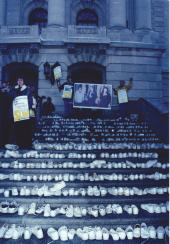
One of the most memorable labour disputes in Saskatchewan occurred in the spring and early summer of 1999: over 8,400 members of the Saskatchewan Union of Nurses (SUN) began negotiations with the Saskatchewan Association of Health Organizations (SAHO) in November 1998; no agreement having been reached on the issues of wages and heavy workloads caused by a shortage of nurses, SUN members on December 9 voted to strike if necessary, by a margin of 74%. Negotiations continued for almost four months without success. On April 5, the union served strike notice. A last-minute meeting between Premier Roy Romanow, SUN president Rosalee Longmoore and SAHO board chairperson Brian Rourke failed to resolve the impasse, and SUN members began a province-wide walkout on April 8, 1999, promising to maintain essential services.
That same day, the government passed legislation ordering the nurses to return to work. They refused, staying on the picket lines for a further week despite a court injunction and threats of huge fines. On April 15, SUN president Longmoore offered to ask her members to go back to their jobs while negotiations resumed, if the government would remove the back-to-work legislation and would agree to a memorandum of understanding addressing pay equity and patient safety issues. The Health Minister and SAHO agreed, the memorandum was signed on April 19, the striking nurses returned to work, and mediator Stephen Kelleher was appointed to try to reach a new collective agreement. Talks again broke down four days later, and Kelleher adjourned the proceedings.
On April 27, SUN complied with an April 11 ruling of the court that ordered the union not to call for further strike action by its members. On May 18, George Semeniuk was appointed as a conciliator to get the talks going again; but it was not until July 2 that a tentative agreement was reached, and on July 27 SUN members voted by a 76.6% majority to ratify the new contract. Meanwhile, in response to a contempt-of-court ruling that would have levied a fine of $120,000 on the union, SUN offered to “purge its contempt” by donating the money to hospital foundations in Saskatoon and Regina.
During the strike, nurses held a series of information meetings, rallies and demonstrations around the province. At such a rally in March, SUN members placed hundreds of old duty shoes on the steps of the Legislature: calling this a “Shoe-in,” Longmoore told the public and the media that it “symbolized the nurses who are leaving this profession because of forced overtime and working conditions that are unacceptable and unsafe.” While SUN did not achieve the 22% increase in wages and benefits they wanted, the final package amounted to 13.7%, which was twice what was originally offered. Also, the government announced that it would fund 200 new nursing positions.
Clare Powell
Print EntryHOME | BROWSE BY SUBJECT | ENTRY LIST (A-Z) | IMAGE INDEX | CONTRIBUTOR INDEX | ABOUT THE ENCYCLOPEDIA | SPONSORS TERMS OF USE | COPYRIGHT © 2006 CANADIAN PLAINS RESEARCH CENTER, UNIVERSITY OF REGINA | POWERED BY MERCURY CMS |
|||
| This web site was produced with financial assistance provided by Western Economic Diversification Canada and the Government of Saskatchewan. |
|||
 |
 |
 |
 |
| Ce site Web a été conçu grâce à l'aide financière de Diversification de l'économie de l'Ouest Canada et le gouvernement de la Saskatchewan. |
|||